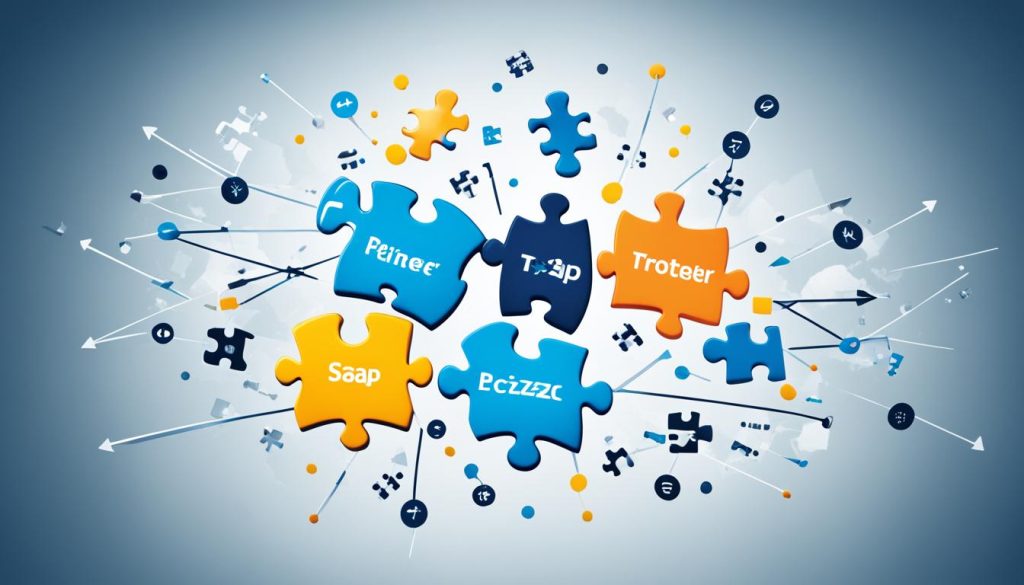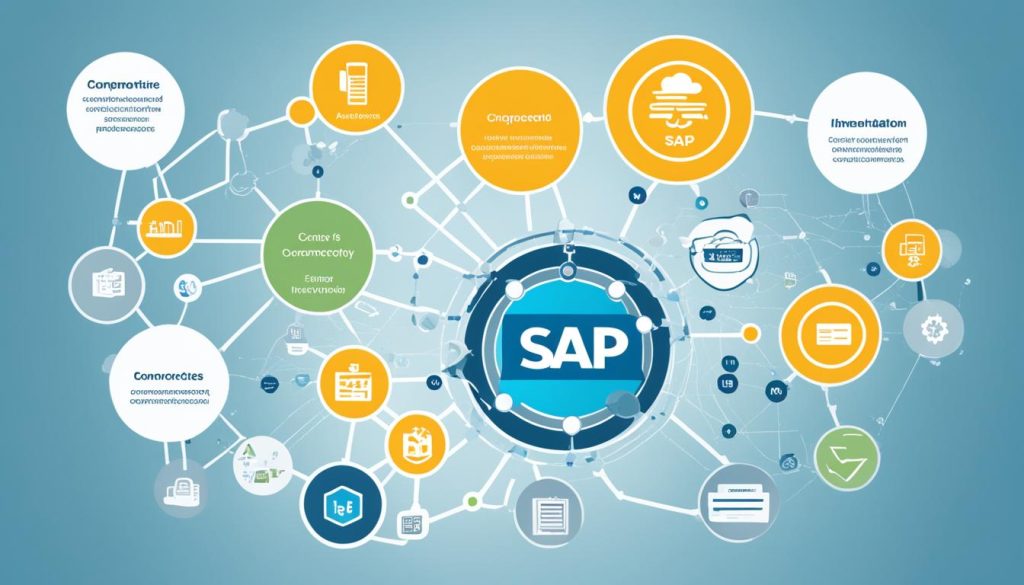SAP is a prominent ERP system trusted by thousands of companies worldwide. As a SAP business consultant, you play a crucial role in helping organizations leverage the power of SAP to optimize their business processes. Seamless integration is key to unlocking the full potential of SAP and delivering exceptional results for your clients.
In this comprehensive guide, we will explore the intricacies of SAP integration and provide strategies for success. Whether you specialize in SAP consulting services, SAP implementation, or SAP software solutions, this guide will equip you with the knowledge and tools to navigate the complexities of SAP integration effectively.
Key Takeaways:
- Understand the challenges of SAP integration in relation to compatibility and system customization.
- Balance customization and integration to ensure scalability and adaptability.
- Navigate the complexity of SAP development and integration with the right tools and expertise.
- Explore key use cases and the benefits of SAP integration for organizations.
- Familiarize yourself with SAP integration tools and options to maximize connectivity.
With the insights gained from this guide, you will be well-equipped to overcome the challenges of SAP integration and deliver seamless solutions that optimize business processes for your clients.
The Challenges of SAP Integration
Integrating SAP can be quite a daunting task due to the unique challenges it presents. The complexity of the SAP system, coupled with the customization often done by companies, can make integration a complex process. SAP has its own technology and processes, which can make it difficult to connect with other software and systems.
One of the main challenges arises from the fact that each customized SAP system may have its own unique configurations and data structures. This uniqueness can create obstacles when attempting to integrate SAP with other systems and software.
Compatibility issues are another common challenge faced during SAP integration. Certain SAP tools may have limited functionality when connecting with non-SAP applications, further complicating the integration process.
To illustrate these challenges, consider the following:
John, an SAP consultant, found it difficult to integrate a customized SAP system with a third-party CRM software. The unique configurations of the SAP system made it challenging to establish seamless data synchronization between the two platforms. This compatibility issue hindered the automation of key processes and resulted in data discrepancies between systems.
Overcoming these challenges requires careful planning and consideration. It is essential to assess the compatibility of SAP integration tools with non-SAP applications and devise strategies to address any potential issues that may arise. Working closely with experienced SAP integration specialists can provide valuable insights and expertise to ensure a successful integration process.
By addressing the challenges of SAP integration head-on, companies can streamline their business processes, optimize data flow, and unlock the full potential of their SAP systems.
Stay tuned as we continue to explore the interplay between customization and integration in SAP environments in the next section.
Navigating the Interplay of Customization and Integration in SAP Environments
When it comes to SAP integration, customization plays a significant role in meeting specific business needs. However, this customization can complicate the integration process and pose challenges for businesses. In SAP environments, different configurations and data structures within customized SAP systems can make it difficult to connect with other software and share data efficiently.
As organizations strive for seamless integration, they often face rising costs and timelines associated with integrating customized SAP systems. This can be a concern, especially when balancing customization and integration becomes vital for scalability and adaptability as business needs change. Finding the right equilibrium between customization and integration is crucial to ensure smooth operations and maximize the value of SAP investments.
Customizing SAP to fit specific business needs can complicate the integration process. Different configurations and data structures within customized SAP systems can make it challenging to connect with other software and share data. The rising costs and timelines associated with integrating customized SAP systems can be a concern for businesses. Balancing customization and integration is essential for scalability and adaptability as business needs change.

| SAP Customization Challenges | Impact on Integration |
|---|---|
| Unique configurations and data structures | Makes integration with other software challenging |
| Rising costs and timelines | Can be a concern for businesses during integration |
| Complexity in balancing customization and integration | Requires careful planning and strategy |
Overcoming these challenges requires a comprehensive approach. Businesses need to assess the customization needs and understand the impact it may have on integration efforts. By collaborating with experienced SAP integration teams and consultants, organizations can navigate the interplay of customization and integration effectively.
By striking the right balance between customization and integration, businesses can optimize their SAP environments to meet their unique requirements. This enables them to streamline their processes, enhance operational efficiency, and achieve seamless connectivity across their systems.
Complexity Considerations with SAP Development and Integration
SAP software is renowned for its complexity, offering countless features and options for seamless integration with other systems. This complexity, though often beneficial, can pose significant challenges in SAP development and integration projects.
The intricate nature of SAP development and integration can result in projects taking a considerable amount of time to complete and consuming valuable resources. The wide range of features and customization options available within SAP solutions make it necessary to carefully plan and allocate resources for successful implementation.
Furthermore, the complexity can contribute to a backlog of requests and frustrations among employees, impeding productivity and efficiency. As such, it is crucial to proactively address these challenges and overcome them to achieve smooth and efficient SAP development and integration.
To navigate the complexity of SAP development and integration, it is essential to leverage the right tools and technologies. SAP provides a diverse range of integration tools that are specifically designed to simplify the process, streamline workflows, and overcome compatibility barriers.
Collaborating with an experienced SAP integration team can also prove invaluable in tackling the complexities associated with SAP development and integration projects. Their expertise and deep understanding of SAP systems allow them to navigate challenges effectively, ensuring a successful integration process.
A comprehensive understanding of the complexity of SAP development and integration, coupled with the strategic use of SAP integration tools and the support of skilled professionals, enables organizations to overcome obstacles and achieve seamless integration outcomes.

Image: Complexity Considerations with SAP Development and Integration.
SAP Integration: Key Use Cases
SAP integration offers a wide range of use cases and benefits for organizations. By leveraging SAP integration, businesses can streamline their operations, enhance data-driven decision-making, and improve user experience. Here are some key use cases and approaches to SAP integration:
1. Master Data Synchronization
Master data synchronization enables organizations to consolidate data from diverse sources into a single, centralized location within the SAP system. By ensuring data consistency and accuracy, businesses can make informed decisions based on reliable information. This use case is particularly valuable for organizations with multiple systems and departments.
2. Application-to-Application Integration
Application-to-application (A2A) integration bridges the gap between different applications, allowing seamless data flow and process automation. With A2A integration, organizations can eliminate manual data entry and streamline their enterprise systems, reducing errors and improving overall efficiency.
3. Business-to-Business Data Integration
Business-to-business (B2B) data integration focuses on integrating and harmonizing data across various solutions used by different business partners. By syncing data and processes, organizations can collaborate more effectively, enhance supply chain management, and optimize business processes. B2B integration is essential for industries with complex value chains, such as manufacturing and retail.
4. User-Centric Integration
User-centric integration aims to provide a unified and seamless platform for users, integrating SAP with other applications to create a seamless user experience. By enabling users to access information and perform tasks within a unified interface, organizations can enhance productivity, reduce training efforts, and drive user adoption.
| Use Case | Benefits |
|---|---|
| Master Data Synchronization | Consolidated and accurate data for informed decision-making |
| Application-to-Application Integration | Streamlined processes, reduced manual effort, and improved efficiency |
| Business-to-Business Data Integration | Enhanced collaboration, optimized supply chain management, and streamlined business processes |
| User-Centric Integration | Improved user experience, increased productivity, and higher user adoption |
By understanding these key use cases and selecting the appropriate integration approach, organizations can unlock substantial benefits from SAP integration. Whether it’s consolidating data, automating processes, optimizing collaboration, or enhancing user experience, SAP integration offers versatile solutions to address various business needs.

SAP Integration Tools
When it comes to integrating SAP solutions with other applications, SAP offers a wide range of tools and options. These tools are designed to streamline the integration process and ensure seamless connectivity between SAP and non-SAP systems.
One of the key integration options provided by SAP is application-to-application integration. This approach enables organizations to connect and synchronize data between different applications, enhancing overall data management and operational efficiency.
Additionally, SAP offers integration methodologies such as SAP ISA-M and extension architecture. SAP ISA-M (Industry Standards Architecture for Media) provides a standardized framework for integrating media-related applications with SAP, ensuring efficient collaboration and data exchange.
The extension architecture allows businesses to extend and enhance SAP functionalities by integrating third-party extensions and custom-developed applications. This flexibility enables organizations to tailor SAP to their specific needs while ensuring seamless integration with existing systems.
Key Features of SAP Integration Tools:
- Streamlined application-to-application integration
- Seamless synchronization of data
- Standardized framework for industry-specific integration
- Flexibility to extend and enhance SAP functionalities
Understanding the functionalities and capabilities of these SAP integration tools is crucial for successful integration projects. By leveraging the right tools, businesses can unlock the full potential of SAP and ensure a smooth flow of data and processes across their entire ecosystem.
| Tool | Key Features |
|---|---|
| SAP ISA-M | Standardized framework for media-related integration |
| Extension Architecture | Flexibility to extend and enhance SAP functionalities |
| Application-to-Application Integration | Streamlined integration between SAP and other applications |
To further illustrate the benefits and features of SAP integration tools, here’s an example:
“By leveraging SAP’s application-to-application integration tool, Company XYZ was able to seamlessly connect its SAP ERP system with its CRM platform. This integration enabled real-time data synchronization between sales and customer service departments, resulting in improved customer satisfaction and streamlined sales processes.”
By leveraging the right SAP integration tools, businesses can optimize their operations, enhance collaboration, and maximize the value of their SAP investments.
Conclusion
SAP integration is a critical aspect of optimizing business processes and achieving success for organizations. As SAP business consultants, we understand the challenges and intricacies associated with seamless integration. By navigating the complexities of customization, compatibility, and complexity, we can help our clients unlock the full potential of their SAP systems and enhance operational efficiency.
With the right SAP integration strategies and tools, businesses can transform their operations and thrive in today’s competitive market. Our expertise in SAP integration allows us to provide tailored solutions that align with the unique needs of each organization. By seamlessly connecting SAP with other applications and data sources, we enable businesses to streamline their processes, improve data accuracy, and make more informed decisions.
Optimizing business processes through seamless SAP integration is not just a goal; it’s a strategic imperative for organizations seeking to stay ahead. As SAP business consultants, we are dedicated to helping our clients leverage the full potential of their SAP systems and achieve their business objectives. With our experience and expertise, we can guide businesses through the integration journey and ensure a smooth and successful implementation.




No comments! Be the first commenter?